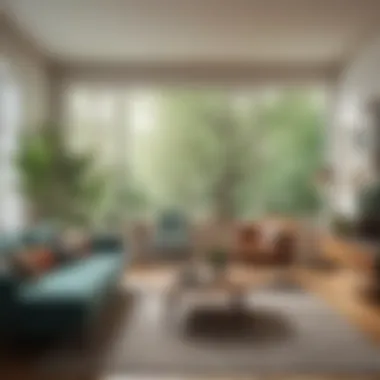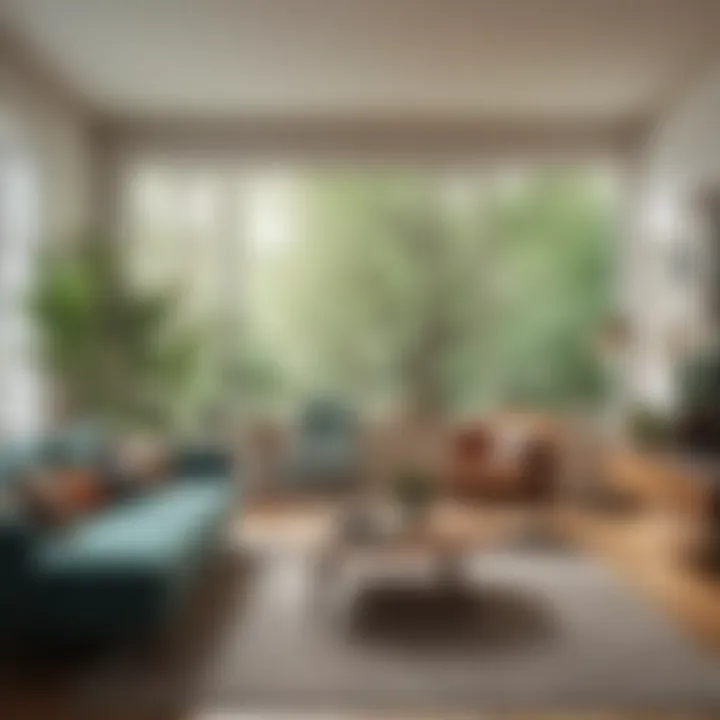Elegant Mid Century Modern Design for Small Living Rooms


Intro
Small living rooms often present a unique challenge for homeowners, demanding both creativity and precision in design. Mid-century modern style emerges as an excellent solution, favoring simplicity and functionality without compromising aesthetic appeal. With its clean lines, organic forms, and emphasis on minimalism, this design approach enables even compact spaces to flourish with style.
In this article, we will take a detailed look at how to effectively apply mid-century modern principles to small living rooms. By focusing on practical aspects—from furniture selection to color choices—we aim to help you create an inviting space that feels both open and chic.
We'll also explore the nuances of layout, ensuring that every piece works harmoniously within the confines of the room. So, whether you're an interior design enthusiast or a homeowner eager to enhance your space, this guide will provide you with the insights and tools needed to turn your modest living room into a mid-century modern masterpiece.
Understanding Mid Century Modern Design
Understanding mid-century modern design is a cornerstone for anyone seeking to create a small living room that balances style and functionality. This design ideology captures a unique blend of aesthetics from the mid-20th century, making it particularly appealing for contemporary homeowners and design enthusiasts. By grasping the fundamental elements of mid-century modern design, one can appreciate how it enhances not only aesthetics but also the overall experience of living spaces.
This section outlines the significance of the mid-century modern movement, which revolves around simplicity, practicality, and a connection to nature. By immersing oneself in its principles, individuals can craft intimate yet stylish environments that resonate with their personality and preferences.
Defining the Aesthetic
Mid-century modern design is characterized by its clean, uncluttered lines, organic shapes, and seamless integration of the indoors with the outdoors. It’s more than just furniture; it’s a way of living that promotes tranquility and ease. Think of it like making a gourmet meal; the ingredients need to complement each other for the final dish to be palatable. In this style, every piece of furniture and decor plays a crucial role in creating an inviting atmosphere.
The aesthetic is often livened up with vibrant colors and geometrical shapes that inject energy into otherwise minimalist spaces, making it an excellent fit for smaller living rooms needing a bit of flair.
Historical Context and Influences
To truly appreciate mid-century modern design, one must understand its historical backdrop. Emerging in the 1940s and gaining momentum into the 1960s, it was born out of a post-war desire for fresh beginnings. The need for practical, affordable housing tied well with a yearning for artistic freedom, leading to innovative design practices. Notable designers like Charles and Ray Eames, and George Nelson gained recognition during this time, pushing the envelope of what home design could be. The influences were everywhere; from Scandinavian simplicity to American industrialism, feeding into this ethos that values function without sacrificing form.
As this design philosophy evolved, accessibility became a guiding principle, enabling a broader audience to embrace mid-century elements in their homes. Knowing this context helps homeowners see how their living space can connect to a larger narrative.
Key Characteristics
One cannot discuss mid-century modern design without mentioning its prominent features. These characteristics set the tone and define the atmosphere of small living rooms.
Clean Lines
Clean lines in furniture and architecture act like brushstrokes on a canvas. They provide a sophistication that creates openness, which is crucial for small spaces. Slender profiles and geometric shapes enable the eye to travel through the room without feeling cluttered. This quality contributes to a sense of spaciousness and tranquility, making it a popular choice for those looking to maximize their living areas.
Additionally, clean lines are versatile, harmonizing well with various colors and textures, ensuring that each element can shine without clashing. However, one might argue that an overemphasis on this aspect could lead to a sterile atmosphere if not balanced with warmth.
Functional Forms
Functional forms are all about utility without forfeiting style. Each piece in a mid-century modern setting tends to serve multiple purposes—like a sofa bed that folds out for guests or a coffee table with integrated storage. It’s a design philosophy born from necessity, making it highly suitable for compact living arrangements.
These forms embody the notion of minimalism while also providing comfort and ease of use. Still, homeowners should be wary of compromising comfort for sleekness, as it should ultimately feel welcoming and livable.
Natural Materials
Natural materials bring the outside in, which is essential for creating a cozy yet stylish vibe. Wood, leather, and stone are favored choices in mid-century modern design. They bring a warmth that synthetic materials often lack, effectively bridging the gap between indoor living and the natural world.
Opting for pieces made from sustainable sources can also resonate well with environmental consciousness, a growing consideration in today's design choices. However, the challenge lies in maintaining these materials, as they may weather over time, requiring attention to upkeep that some may find cumbersome.
By understanding these distinct elements of mid-century modern design, individuals can navigate their journey toward creating an aesthetically pleasing and functional small living room.
Designing a Small Living Room
Designing a small living room is a task that requires a blend of creativity and practicality. For those dwelling in compact spaces, the living area serves not only as a gathering spot but also as a reflection of personal style. The significance of this section is rooted in understanding how mid-century modern principles can be intricately woven into a smaller living space, making it both functional and aesthetically pleasing. Mid-century modern design thrives on minimalism, which naturally aligns with the need to maximize utility in smaller areas.
One of the key considerations in designing a small living room lies in selecting the right furniture. The goal here isn’t just about fitting everything in; it’s about choosing pieces that enhance the space without overwhelming it. A focus on functional forms means that each piece should serve a purpose—like a sleek sofa that doesn’t take up too much visual room while providing comfort.
Challenges of Small Spaces
Living in a tight space is akin to solving a puzzle—every piece must fit just right. The challenges that come with small living rooms can often be daunting. Limited square footage can lead to feelings of claustrophobia if one isn’t careful. A common issue is overcrowding with furniture, making it difficult to navigate the area efficiently. It's also easy for small spaces to feel chaotic if not organized properly.
The lack of storage can add another layer of complexity. Possessions can clutter the living room faster than you can say "mid-century modern!" Thus, homeowners must be intentional with their design choices. To prevent chaos:
- Opt for furniture with built-in storage: This allows you to tuck away items without sacrificing style. For instance, ottomans or coffee tables with concealed compartments can work wonders.
- Keep a neutral palette: Lighter colors tend to open up spaces visually, creating an airy feel.
- Be mindful of scale: Selecting oversized furniture in a small room can make the entire area seem cramped.
Benefits of Mid Century Modern in Small Areas
Choosing to incorporate mid-century modern design into a small living room can turn potential obstacles into advantages. The beauty of this aesthetic lies in its ability to complement small spaces harmoniously. Here are several perks:


- Timeless Design: Mid-century modern pieces are often characterized by their clean lines and functional beauty, making them less likely to go out of style. This ensures that your small living room remains relevant for years to come.
- Focus on Functionality: As already mentioned, this design philosophy emphasizes practicality. Each furniture item serves multiple purposes, ideal for those who need to get the most out of their limited space.
- Integration of Light: Large windows and open layouts are staples in mid-century modern homes, allowing for natural light to flood the room. This illumination helps create a sense of openness, an invaluable trait for small living areas.
- Natural Materials: The use of wood, leather, and metal in mid-century designs creates warmth and texture. This connection to nature can transform a small living area into a welcoming retreat.
Furniture Selection
Choosing the right furniture can make or break the feel of a small living room. In a mid-century modern design context, furniture selection is not just about filling space; it's about enhancing functionality while maintaining aesthetic appeal.
When furniture works harmoniously, it creates an inviting atmosphere, allows for better movement, and transforms how the space is perceived. Opting for mid-century modern pieces means embracing simplicity, which in turn brings clarity and elegance into tight areas. Paying attention to every detail helps in fostering a cozy yet stylish environment for relaxation and socializing.
Key Furniture Pieces
Sofas and Seating
Sofas embody the spirit of a living room and their impact on design and comfort cannot be overstated. Mid-century modern sofas typically feature clean lines and a low profile which helps visually elongate smaller spaces. A popular choice often includes the classic Togo Sofa by Ligne Roset, known for its unique soft structure that wraps around you.
- Space efficiency: With their streamlined forms, these sofas snugly fit within confined spaces, making them more accommodating than bulkier models.
- Versatility: The variety of colors and materials allows for personalization. Those bold, vibrant hues or neutral tones work equally well to suit your taste.
- Drawbacks: However, consider that some low seating models may not suit every age group or might require frequent fluffing to keep them looking plush.
Tables and Desks
Tables and desks serve as functional focal points in small living rooms. A classic piece like the Saarinen Tulip Table can be jaw-dropping despite its small footprint.
- Elegant design: Its round shape and slender base promote a sense of openness. This encourages conversation while enhancing flow, which is key in small areas.
- Functionality: These tables can multitask as dining spaces or work areas, requiring careful attention to size. A small drop-leaf table could also be an option, providing flexibility depending on your needs.
- Limitations: Keep in mind, a table's surface area must accommodate your activities without cluttering the room. Too many decorative items can overwhelm minimalistic design.
Storage Solutions
In the realm of small living rooms, efficient storage solutions are necessary to keep chaos at bay. Mid-century modern storage pieces like Credenzas or Floating Shelves exemplify functional yet stylish choices.
- Stylized practicality: Most storage solutions would typically feature a combination of drawers for hiding clutter as well as open compartments to display select items. This duality is a hallmark of the design aesthetic.
- Space-saving designs: By introducing vertical storage solutions, like a tall bookshelf, you can utilize upward space without taking up unnecessary floor real estate.
- Challenges: On the downside, some floating shelves may struggle under heavier loads, so ensuring your decor selection remains lightweight is key.
Scale and Proportions
Size matters. Maintaining the right scale ensures that your furniture doesn’t overwhelm the space. Use furniture that has proportions suitable for small dimensions, keeping in mind how each piece relates to others. The overall look should feel balanced, with no items looking out of place.
Multi-functional Furniture Options
When space is tight, multi-functional furniture can be a lifesaver. Whether it’s a sofa bed like the IKEA FÄRLÖV, which offers a comfy sleep solution, or an ottoman that doubles as a storage box, this type of furniture maximizes utility.
- Versatile solutions: Pieces that serve more than one purpose can seamlessly blend in while enhancing the area’s practicality.
- Smart choices: Opt for lightweight designs that allow for easy rearrangement, keeping options open for gatherings or everyday living.
Color Palettes
When it comes to designing a small living room, color selection isn't just a detail; it’s a cornerstone of the entire design. Mid-century modern spaces often lean on hues that evoke calm, creativity, and cohesiveness. The right color palette can create an inviting ambiance, making the room feel larger and more dynamic. It adds personality and can even dictate the mood within the space. This section will break down how to make informed color choices that harmonize well with mid-century modern design principles while also addressing the unique challenges of smaller living rooms.
Choosing Complementary Colors
In the world of interior design, complementary colors are like old friends—they work together to create a balance that’s appealing to the eye. When selecting a palette for a small living room, think about how colors interact. For instance, pairing a soft, muted tone like sage green with a richer, warm shade such as terra cotta can add depth to the space.
Using a color wheel can be a handy tool here. When you find colors that sit opposite each other on the wheel, they tend to enhance each other's vibrancy. This contrast can make your furniture and accessories pop. Also, remember to consider the undertones of your choices; a color may shift dramatically when placed next to another.
Neutral Base with Vibrant Accents
A strategy that's often used in smaller spaces is starting with a neutral base. Think of light greys, whites, or beiges as your canvas. These colors reflect light, making a room appear bigger. After establishing that foundation, adding vibrant accents is where the magic happens.
Imagine bright mustard yellows or deep ocean blues in cushions or artwork against a neutral backdrop. Such pops of color attract attention and can create focal points without overwhelming the space. Remember, it’s about balance—too many bright colors can make the room feel chaotic. Find that sweet spot where the vibrancy enhances without bogging down the openness of your living area.
Integrating Natural Elements
Incorporating colors found in nature is a hallmark of mid-century modern design. Think browns, greens, and hues inspired by rocks or plants. Not only do these colors tie nicely with the philosophy of using natural materials, but they also bring a sense of tranquility inside.
For a small living room, accentuating the natural colors helps in blending the indoors with the outdoors. You can achieve this by integrating natural wood tones, either in your furniture or flooring, and pairing them with plant life. A lush potted fern or a simple succulent will not only infuse life into the space but also reinforce the color choices made elsewhere in the room.
"Color is the keyboard, the eyes are the harmonies, the soul is the piano with many strings." - Wassily Kandinsky
Ending on Color Palettes
Each element discussed here—from selecting complementary colors to mixing in natural tones—plays a crucial role in defining how one experiences a small living room. Color isn’t just about aesthetics; it’s instrumental in crafting an environment that feels both spacious and intimate, hallmarks of the mid-century modern ethos. By thoughtfully applying these strategies, homeowners can create a small living space that doesn’t just exist but thrives.
Decor and Accessories
In the realm of mid-century modern small living room design, decor and accessories play a pivotal role. They are not just embellishments; they can transform a room from ordinary to extraordinary. Each piece serves as a reflection of personal style, contributing layers of texture, color, and intrigue to the overall space. When working with limited square footage, intentionality in decor choices becomes crucial. This section will delve into the significance of art, textiles, and natural light as key elements to enhance your small living room.


Art and Wall Decor
Art holds a mirror to one's taste and personality. For a mid-century modern space, wall decor should echo the clean lines and organic forms characteristic of the era. Bold, geometric patterns or abstract pieces are often ideal, as they can inject life into a room without overwhelming it. Hanging artwork at eye level is a simple trick to create visual balance, making a space feel larger and more open.
In a small living room, using larger pieces of art can be more effective than multiple smaller items that clutter the wall. Such choices also contribute to the illusion of space, as they draw the eye and create focal points. Don't shy away from frames in wood or metal; these materials resonate well with the natural essence of mid-century design.
Textiles and Soft Furnishings
Textiles breathe warmth and coziness into small living rooms. The fabrics you choose can usher in color, pattern, and comfort, creating a homely feel. Here’s how various soft furnishings impact your design:
Rugs
A rug serves as a foundation for the living room. It can help delineate areas, especially in open floor plans, making the space feel more integrated yet separated. Choose a rug with a low pile to avoid feeling congested.
One popular characteristic of rugs in mid-century design is bold, graphic patterns. This characteristic not only helps in tying the room together but also adds a touch of artistic flair. Another unique feature of area rugs is their ability to absorb sound, which can be an advantage in smaller spaces where acoustics matter. However, they can sometimes feel tricky to clean, meaning that opting for durable materials is key.
Cushions
Cushions are like the icing on the cake—they bring comfort and vibrancy to sofas and chairs. One key aspect is their versatility. You can easily swap them out seasonally or whenever a new color trend strikes your fancy. By mixing and matching patterns and textures, cushions can also deepen the visual interest of your overall presentation.
Nevertheless, be mindful not to overcrowd your seating areas with too many cushions. Balance is key; just enough plush comfort makes for a welcoming spot without crowding the space.
Throws
Throws provide both comfort and aesthetic appeal. Not only do they deliver warmth during chill evenings, but they also encourage a sense of coziness. A standout characteristic of throws is their ability to add a pop of color or an intricate pattern to basic furniture. They can be draped elegantly over a chair or tossed onto the couch, enhancing the visual story of a living room with effortless style.
One consideration with throws, however, is that they require maintenance to keep them looking fresh, especially if they are made from lighter materials that can attract dust or stains. By choosing machine-washable options, you can balance practicality with style.
Emphasizing Natural Light
Natural light is perhaps the most sought-after element in any living room, especially small ones. It can enhance the perception of space and improve the overall ambiance.
Large, unobstructed windows allow light to flood the room, creating an airy feel. The strategic placement of mirrors can further amplify this effect, causing light to bounce around, making the space feel twice as large.
When selecting window treatments, think about how you can control the light without completely blocking it out. Light fabrics or sheer curtains can still afford intimacy while basking the space in a soft glow. In essence, the interplay between light and decor can greatly enhance your small living room’s charm, aligning perfectly with the mid-century modern ethos.
"The way you light a space can change its entire mood; choose wisely, and let the light guide your design."
Crafting a small living room along mid-century modern lines requires careful consideration of decor and accessories. From art that resonates with your identity to textiles that provide comfort, each detail should be harmoniously integrated to achieve a stylish, airy sanctuary.
Maximizing Space
In small living rooms, the challenge of maximizing space can seem like an uphill battle. Yet, with the right approach grounded in mid-century modern principles, it’s possible to transform even the tiniest areas into functional, stylish retreats. This section tackles the relevance of maximizing space, spotlighting strategies to make every square foot work without cramping your style.
Utilizing Vertical Space
Vertical space is a game changer, especially when the floor space is at a premium. Instead of letting your walls sit empty, consider them as an opportunity to extend your design beyond the horizontal plane. Here are some thoughtful strategies to embrace verticality:
- Tall Shelving Units: These pieces not only provide storage but can also double as statement art. Opt for designs with open shelving to keep it from feeling overwhelming. Items placed vertically draw the eye upwards, creating an illusion of more space.
- Wall-mounted Accessories: Think about wall-mounted lighting or decorative elements. For example, using sconces instead of table lamps frees up precious surfaces, making a small room feel less cluttered.
- Hanging Plants: Incorporating greenery is a staple of mid-century modern design. You can hang pots from the ceiling or wall hooks, bringing life to even the smallest areas without occupying valuable floor space.
Utilizing vertical space not only enhances functionality but also adds depth to the room, making it feel more expansive and airy.
Strategies for Decluttering
Decluttering might feel like a daunting task, yet it's crucial for achieving that clean, minimal aesthetic synonymous with mid-century modern design. A cluttered space quickly becomes overwhelming, negating the beauty of your carefully chosen pieces. Here are effective strategies to help you streamline your living room:
- Implement the 'One In, One Out' Rule: For every new item you bring into your space, let go of another. This helps maintain balance and prevents accumulation of unnecessary items.
- Use Smart Storage Solutions: Look for multifunctional furniture—like ottomans with storage inside or coffee tables with shelves underneath—to keep things organized without sacrificing style.
- Regularly Review Your Decor: Periodically evaluate your items. If something no longer sparks joy or serves a purpose, consider donating or selling it. This keeps your space feeling fresh and light.
"A tidy space can significantly impact mood and functionality. Less really can be more, especially in small areas."
By implementing these decluttering strategies, you can create an environment that fosters relaxation and enjoyment. A well-organized space reflects the essence of mid-century modern design: simplicity combined with intentionality.
Incorporating Nature
In the context of mid-century modern small living room design, incorporating nature is not just an aesthetic addition; it’s a fundamental principle. This approach not only brings life to a space but also enhances well-being, creating an atmosphere of tranquility that aligns perfectly with the clean and functional lines of mid-century modern decor. Integrating elements from the natural world adds depth, warmth, and an organic balance to small living areas often constrained by spatial limitations.
Indoor Plants
Indoor plants are more than just decorative items; they are living elements that purify the air and elevate the mood. In small living rooms, the correct selection of plants can breathe life into any corner, creating a sense of freshness and serenity. Consider a few snake plants or a compact fiddle-leaf fig—they are easy to care for and have a sculptural quality that complements the mid-century aesthetic.
"Plants not only beautify the space, but they also have a calming effect, making the small living room feel more expansive and inviting.”
When adding indoor plants, think of various heights and textures to create an engaging visual arrangement. A taller plant can draw the eye upward, which can offer an illusion of height in a small room. Additionally, using unique pots that embody the mid-century modern style—such as those in muted earth tones or geometric shapes—can enhance the overall decor.
Natural Light and Ventilation
Natural light is a cornerstone of a well-designed small living room, particularly in mid-century modern spaces where an open, airy feel is paramount. Large windows or strategically placed mirrors can significantly increase light flow, making the room feel larger than it is. The essence of mid-century modern design thrives on blending indoor and outdoor spaces seamlessly, turning walls into portals of nature.
Moreover, ventilation plays a crucial role in maintaining a comfortable atmosphere. Between using breezy curtains and installing cleverly-designed window openings, you can facilitate air circulation without sacrificing style. This not only keeps the space fresh but also complements the natural materials used in furniture and decor.


In summary, incorporating nature into a small mid-century modern living room provides aesthetic beauty and practical benefits, enriching the living space with essence and comfort. The goal is to create a harmonious balance where the structure and decor of the room resonate with the natural world, encouraging peace and satisfaction.
Personalizing the Space
When it comes to creating a small living room that echoes mid-century modern design, personalizing the space can’t be overlooked. It's the difference between a room that feels sterile, almost like a showroom, and one that resonates with warmth and individual character. Personalization allows homeowners to carve out a niche that reflects their tastes, lifestyle, and preferences, making the living area not just functional, but a genuine home.
One of the key elements of personalization is incorporating items that tell a story—objects that hold memories or represent experiences in life. Whether it’s a vintage vase from a flea market trip or art from a local artist, these pieces can be conversation starters and focal points in the room.
Reflecting Individual Style
To truly reflect individual style, one must focus on what aspects of mid-century modern appeal the most. Does one lean towards the sleek look of walnut furniture? Perhaps the bold colors and geometric patterns that were so prevalent in that era? Consider using these preferences to guide choices in color schemes and furniture selection.
Furthermore, personal style can shine through in the arrangement of furniture. For instance, positioning a striking Eames lounge chair in a spot that catches the light can not only show off the chair itself but also create a cozy reading nook. Thinking about how the personal style interacts with layout can enhance functionality while still keeping aesthetics in mind.
"You should feel happy in your space. It should be a reflection of who you are, not who someone else wants you to be."
Finding Unique Pieces
Finding unique pieces for your mid-century modern small living room can be like hunting for treasure. Instead of purchasing everything new, explore second-hand shops, estate sales, and online marketplaces to uncover hidden gems. Often, these unique items carry their own history, which can add depth to your living room.
- Local thrift shops: A goldmine for one-of-a-kind items. You never know what might pop up, from quirky lamps to stunning art.
- Online marketplaces: Sites like Facebook Marketplace and Etsy can lead to some exceptional finds, not just from your local area but sometimes even from overseas sellers who specialize in mid-century modern decor.
- Antique stores: While prices can vary significantly, some stores occasionally have great deals on vintage furniture that challenges the conventional look.
Consider making a list of pieces that would elevate your space, whether that be a specific style of coffee table or a rare wall clock. Having these details in mind can make the search more purposeful, ensuring the collected items blend seamlessly into the overall design.
Personalizing a mid-century modern living room is about enhancing the environment with character and individuality. By reflecting one’s style and seeking out unique items, the space can transform into a personal retreat that is both functional and aesthetically pleasing.
Sustainable Practices in Design
In today’s world, sustainability isn’t just a trend; it’s a necessary mindset that influences how we design our spaces. For small living rooms, the application of sustainable practices within mid-century modern design can enhance both aesthetic appeal and practicality. Choosing eco-friendly materials and adopting strategies like repurposing provide not only environmental benefits but also create a unique character in the home. These practices invite one to tread softly on the planet while enjoying stylish interiors that reflect a conscientious approach to design.
Choosing Eco-friendly Materials
Steering clear of high-carbon footprint materials can bring numerous advantages for homeowners. Eco-friendly materials—such as bamboo, reclaimed wood, and recycled metals—are not only sustainable but also embody the clean lines and functional forms characteristic of mid-century modern design. For instance, using bamboo furniture contributes to an elegant yet practical vibe, as bamboo grows rapidly and generates much less waste compared to traditional hardwoods.
A few options to consider:
- Bamboo: Lightweight, durable, and versatile.
- Reclaimed wood: Offers a vintage charm while reducing the need for new lumber.
- Recycled metal: Perfect for accents and furnishings, providing sleek looks while being environmentally responsible.
Additionally, many fabrics are now produced using organic materials or non-toxic dyes, allowing you to craft a cozy living room ambiance that is both beautiful and eco-conscious.
"Sustainability in design is driven by the desire to balance aesthetic appeal with responsibility towards our environment."
Repurposing and Upcycling Ideas
Incorporating upcycled elements into your living space is a brilliant way to turn something old into a fresh focal point. Rather than discarding furniture or decor, consider how these items could have a second life in a small living room. This practice not only helps cut down waste but also adds depth and history to the interior.
Some inspiring ideas for upcycling include:
- Transforming vintage suitcases into stylish side tables or stacked storage solutions. This gives an eclectic flair while being functional.
- Refurbishing an old chair with a fresh coat of paint and an updated cushion—this process can be a weekend project that yields satisfying results.
- Using wine crates as shelves or decorative storage, which complements the natural material ethos of mid-century modern design.
The End
Designing a small living room in the mid-century modern style is much more than just picking out furniture and paint colors. It represents a thoughtful approach to how we inhabit our spaces, emphasizing the elegance of simplicity while not compromising on function. A well-integrated design celebrates the strengths of the mid-century era, ensuring that every piece is purposeful and speaks to the aesthetic's core values.
One of the primary benefits of this approach is its innate ability to make small spaces feel larger and more inviting. When executed properly, the combination of clean lines and open concepts creates a seamless flow that can be refreshing in a compact setting. Furthermore, the emphasis on natural materials combined with a restrained palette adds warmth, making it a cozy sanctuary even in tight quarters.
It’s essential to consider not just the visual aspects of integration, but also how the design choices impact daily life. The right furniture pieces can serve multiple functions—like a sleek ottoman that doubles as storage or a compact dining table that can become a makeshift workspace. By choosing elements that harmonize with one another, you cultivate an atmosphere of calm and order that is often difficult to achieve in smaller living areas.
"Mid-century modern design is like a breath of fresh air in a crowded room; it brings clarity and purpose to design choices."
In transforming your small space, also remember to include personal touches that reflect your style. This will not only enrich your living experience but root your home in a sense of individuality amidst its clean and organized form.
Final Thoughts on Design Integration
As we wrap up our discussion on mid-century modern small living room design, it's clear that integration plays a pivotal role in achieving a harmonious atmosphere. The beauty of mid-century design lies in its ability to marry aesthetics with functionality. Clean lines, natural forms, and purposeful layouts can elevate your space, making it both livable and inviting. Keep in mind that every detail counts.
For instance, consider the use of textiles. Textures can soften sharp lines, while art and decor pieces can serve as focal points that tie elements together. When designing, think of the room as a canvas—every choice, whether large or small, can influence the overall feel.
Encouragement for Personal Expression
In any design endeavor, especially in small living rooms, personal expression should never be overlooked. Your space is a reflection of who you are; it's important to infuse it with pieces that tell your story. Mid-century modern design invites you to play with color, texture, and form while also allowing room for individuality.
Incorporate items that hold significance—perhaps a vintage lamp you found at a flea market or a piece of art created by a local artist. This not only personalizes your space but also invites conversation. Mix and match contemporary elements with vintage finds; the contrast can be a striking way to showcase your taste.
Remember, designing with heart is crucial. Don’t shy away from making bold choices. Allow your small living room to evolve into a space that feels authentically yours while adhering to the fundamental principles of mid-century modern design.















